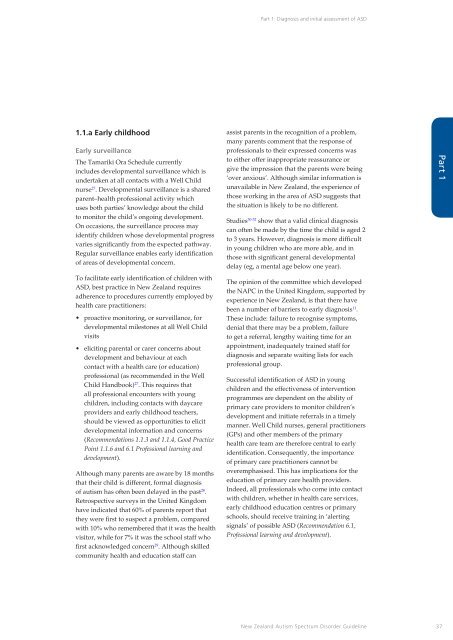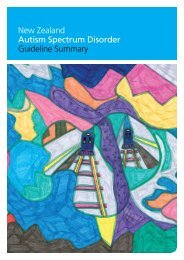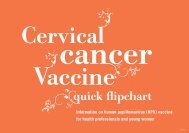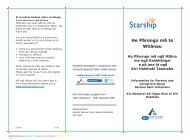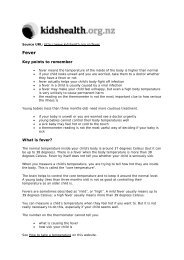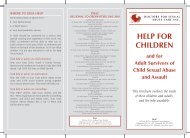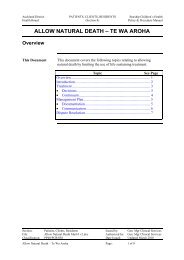New Zealand Autism Spectrum Disorder Guideline - Ministry of Health
New Zealand Autism Spectrum Disorder Guideline - Ministry of Health
New Zealand Autism Spectrum Disorder Guideline - Ministry of Health
Create successful ePaper yourself
Turn your PDF publications into a flip-book with our unique Google optimized e-Paper software.
Part 1: Diagnosis and initial assessment <strong>of</strong> ASD<br />
1.1.a Early childhood<br />
Early surveillance<br />
The Tamariki Ora Schedule currently<br />
includes developmental surveillance which is<br />
undertaken at all contacts with a Well Child<br />
nurse 27 . Developmental surveillance is a shared<br />
parent–health pr<strong>of</strong>essional activity which<br />
uses both parties’ knowledge about the child<br />
to monitor the child’s ongoing development.<br />
On occasions, the surveillance process may<br />
identify children whose developmental progress<br />
varies significantly from the expected pathway.<br />
Regular surveillance enables early identification<br />
<strong>of</strong> areas <strong>of</strong> developmental concern.<br />
To facilitate early identification <strong>of</strong> children with<br />
ASD, best practice in <strong>New</strong> <strong>Zealand</strong> requires<br />
adherence to procedures currently employed by<br />
health care practitioners:<br />
• proactive monitoring, or surveillance, for<br />
developmental milestones at all Well Child<br />
visits<br />
• eliciting parental or carer concerns about<br />
development and behaviour at each<br />
contact with a health care (or education)<br />
pr<strong>of</strong>essional (as recommended in the Well<br />
Child Handbook) 27 . This requires that<br />
all pr<strong>of</strong>essional encounters with young<br />
children, including contacts with daycare<br />
providers and early childhood teachers,<br />
should be viewed as opportunities to elicit<br />
developmental information and concerns<br />
(Recommendations 1.1.3 and 1.1.4, Good Practice<br />
Point 1.1.6 and 6.1 Pr<strong>of</strong>essional learning and<br />
development).<br />
Although many parents are aware by 18 months<br />
that their child is different, formal diagnosis<br />
<strong>of</strong> autism has <strong>of</strong>ten been delayed in the past 28 .<br />
Retrospective surveys in the United Kingdom<br />
have indicated that 60% <strong>of</strong> parents report that<br />
they were first to suspect a problem, compared<br />
with 10% who remembered that it was the health<br />
visitor, while for 7% it was the school staff who<br />
first acknowledged concern 29 . Although skilled<br />
community health and education staff can<br />
assist parents in the recognition <strong>of</strong> a problem,<br />
many parents comment that the response <strong>of</strong><br />
pr<strong>of</strong>essionals to their expressed concerns was<br />
to either <strong>of</strong>fer inappropriate reassurance or<br />
give the impression that the parents were being<br />
‘over anxious’. Although similar information is<br />
unavailable in <strong>New</strong> <strong>Zealand</strong>, the experience <strong>of</strong><br />
those working in the area <strong>of</strong> ASD suggests that<br />
the situation is likely to be no different.<br />
Studies 30-32 show that a valid clinical diagnosis<br />
can <strong>of</strong>ten be made by the time the child is aged 2<br />
to 3 years. However, diagnosis is more difficult<br />
in young children who are more able, and in<br />
those with significant general developmental<br />
delay (eg, a mental age below one year).<br />
The opinion <strong>of</strong> the committee which developed<br />
the NAPC in the United Kingdom, supported by<br />
experience in <strong>New</strong> <strong>Zealand</strong>, is that there have<br />
been a number <strong>of</strong> barriers to early diagnosis 11 .<br />
These include: failure to recognise symptoms,<br />
denial that there may be a problem, failure<br />
to get a referral, lengthy waiting time for an<br />
appointment, inadequately trained staff for<br />
diagnosis and separate waiting lists for each<br />
pr<strong>of</strong>essional group.<br />
Successful identification <strong>of</strong> ASD in young<br />
children and the effectiveness <strong>of</strong> intervention<br />
programmes are dependent on the ability <strong>of</strong><br />
primary care providers to monitor children’s<br />
development and initiate referrals in a timely<br />
manner. Well Child nurses, general practitioners<br />
(GPs) and other members <strong>of</strong> the primary<br />
health care team are therefore central to early<br />
identification. Consequently, the importance<br />
<strong>of</strong> primary care practitioners cannot be<br />
overemphasised. This has implications for the<br />
education <strong>of</strong> primary care health providers.<br />
Indeed, all pr<strong>of</strong>essionals who come into contact<br />
with children, whether in health care services,<br />
early childhood education centres or primary<br />
schools, should receive training in ‘alerting<br />
signals’ <strong>of</strong> possible ASD (Recommendation 6.1,<br />
Pr<strong>of</strong>essional learning and development).<br />
Part 1<br />
<strong>New</strong> <strong>Zealand</strong> <strong>Autism</strong> <strong>Spectrum</strong> <strong>Disorder</strong> <strong>Guideline</strong> 37


